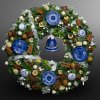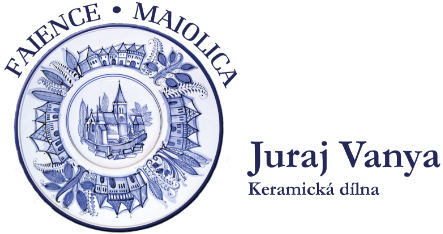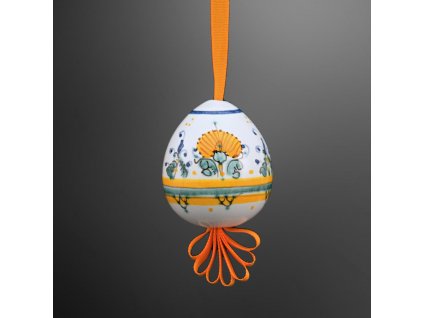
Decorative ceramic ball on a ribbon. White glazed and hand painted with blue decor.

Bell-shaped ceramic mug. Yellow glazed and hand painted with green and white decor. Food safe certificate.

Hand carved lace ceramic plate. Cobalt glazed and hand painted with white decor.

Hand carved lace ceramic plate. White glazed and hand painted with blue decor.

Handmade ceramic pitcher. Ideal to use as a milk jug. White glazed and hand painted with blue decor. Food safe certificate.

Pear-shaped ceramic mug. Yellow glazed and hand painted with green and white decor. Food safe certificate.
Latest rating

Christmas wreath
About us
Juraj Vanya ceramic workshop
Juraj Vanya has been making and decorating ceramics since he was 18 years old. At that time, his desire to become an artist brought him to the Folk Art Production Workshop in Modra. Fate gradually led him to Sedlčany in the Czech Republic, where he gradually established a ceramics workshop and, together with his collaborators, has been making handmade pottery inspired by Habanese designs ever since.
We stick to handmade production 100% of the time. From mixing the clay, shaping the product, to glazing, to painting. Thanks to this, you can count on the fact that each piece is truly original and may not match the photo in the e-shop exactly. All of our utilitarian ceramics have been safety-certified, so you can safely use them when eating out. The delivery time of 21 days that we indicate for our products is purely indicative. We have most of them in stock, or we can produce and dispatch them within a week. Delivery time will only be extended for larger orders.
Newchristians-Hutterites-Habáni in Moravia and Slovakia
The movement to which the Habanists subscribed was founded in 1525 and was based on the Reformation teachings of Martin Luther and Ulrich Zwingli. One of the basic requirements of the New Baptists was to receive baptism only in adulthood, after a profession of faith of the New Baptist's own free will. The New Baptists did not recognize the hierarchy, military service and claimed equality of property. Even in the new conditions after the religious changes in Germany, their secular interpretation of the New Testament was too radical, and they aroused resentment in traditional society by their activities in Germany and the borders with Italy. Therefore, after 1526, the first members of this sect arrived in South Moravia and were accepted by representatives of the high nobility. The nobility lent land to the Haban (probably called "haus haben", sometimes also "Hutterites" after the spiritual leader Jacob Hutter) for building courts and agricultural business. The Habáni proved to be skilled and hard-working craftsmen, especially knifemakers, blacksmiths, potters, but also apothecaries and doctors. Evidence of their knowledge of winemaking still remains in Moravia. The Habáni built enclosed courts in their places of activity, where they practised their faith in isolation from the outside world, worked together in craft workshops and led a very modest family life.
Faience in Europe
The production of faience, for which the Habans in Moravia and Slovakia made their living, made them more famous than other craft activities. The New Christians brought their knowledge of faience production from Italy and Germany. The technology came there from Spain with the Arab population of the Iberian Peninsula (hence the majolica from the Spanish name Mallorca). From the second half of the 15th century until the mid-16th century, Faenza in particular (hence the name faience), and later also Florence and Venice, were famous centres for the production of faience, pottery made from clay at relatively low firing rates of between 900-1000 °C. In northern Europe, the art of faience pottery production penetrated as far as Delft in the Netherlands..
Habanese faience
Despite their isolated way of life, the Moravian and West Slavic habans did not interrupt their contacts with the inspirational centres of faience production in Italy and Delft. Haban ceramics, however, gradually developed its own ornamental and colour language, which was initially still based on a strict interpretation of Scripture in the 16th century (prohibition of depicting figures, choice of colour palette). Thus, until 1612, Habanese faience was characterised by the use of floral and heraldic motifs depicted on a white ground in four basic colours, yellow, green, blue and purple. The New Christians produced ceramic products in their workshops, which found a place in the palaces of the nobility and in the homes of wealthy townspeople, as well as in the pharmacies and wineries of the time. With the advancing pressure of the Counter-Reformation, the favourable conditions for Haban life in Moravia ended after the White Mountain, and the individual Haban communities moved to Slovakia in 1622, where freer conditions prevailed at that time. However, even here, under external pressure, the traditional Haban communities gradually disintegrated and their members merged into the surrounding society (also in connection with the decision of 1685 to abolish the common property). These changes in the spiritual and secular life of the Habanese were also reflected in their ornamental work, the motifs of which were gradually adopted by local folk potters and enriched with Moravian and Slovak folk elements. Some of the newly baptised Hutterites still go to Transylvania, Ukraine and Russia. Active, mainly agricultural hutterite colonies are still thriving, especially in Canada.
Show more
















